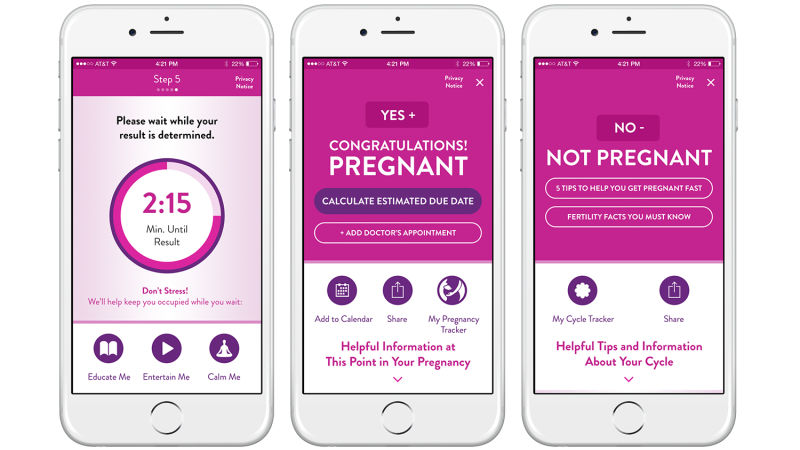
Bluetooth Babies: Reproductive Technology in the Information Age
Technology’s Stories vol. 5, no. 1 – doi: 10.15763/JOU.TS.2017.4.1.02
At this year’s Consumer Electronics Show, Church & Dwight Co., the makers of First Response pregnancy and ovulation test kits, unveiled the latest and greatest innovation in the world of do-it-yourself reproductive testing: the Bluetooth-enabled pregnancy test.[1] Christened the “First Response Pregnancy Pro,” the digital pregnancy test is designed to sync to an app on the user’s mobile device. In addition to providing the user with the test results (“Congratulations! Pregnant” or, less enthusiastically, “No, Not Pregnant”), the app offers “step by step test assurance,” “wait time support” (in the form of viral videos or calming music), and “post-result support.” If the user is indeed pregnant, the app automatically calculates their due date and provides additional information about pregnancy and birth. If the user is not pregnant, the app instead presents tips for tracking fertility, in the hope that the test might offer happier news in one month’s time.

Photo: First Response
When the “Pregnancy Pro” became available on drugstore shelves in April 2016, the backlash was swift and snarky. Slate declared that “There is Absolutely No Need For a Bluetooth Pregnancy-Test App,” while an op-ed in the Washington Post explained “Why I’ll Never Use a Bluetooth Pregnancy Test.” Nicole Lee, Senior Editor for online tech magazine Engadget, most accurately encapsulated public opinion when she insisted, “I don’t need a damn Bluetooth pregnancy test. I really don’t.” At best, the critics of the Bluetooth pregnancy dismissed the product as an opportunistic gimmick. Adding Bluetooth capabilities to a pregnancy test, critics argued, unnecessarily complicated what was an ostensibly simple technology while inflating its price tag. At worst, critics accused the app as being an unsavory strategy for collecting customer data, data that could then be used to sell users even more products throughout their pregnancy and beyond.[2]
At the core of these critiques was the fear that Bluetooth pregnancy tests violated sacred concepts of reproductive privacy. Lee observes that “taking a home pregnancy test is one of the most private rituals that a woman of childbearing age can have,” one that is fundamentally undermined by the involvement of a third-party app. Glamour magazine described the test’s implications for women’s privacy as “terrifying,” while another website decried the “Pregnancy Pro” as a “privacy nightmare.”[3] Indeed, when the at-home pregnancy test made its debut in the United States in 1978, it was lauded by feminists as a tool for helping women maintain reproductive privacy. Before the advent of home testing, women had to consult a medical professional in order to discover their pregnancy status. But as the Boston Women’s Health Book Collective observed in 1984, home tests provided women with “privacy, convenience, and control over the experience.”[4] By adding Bluetooth technology, Church & Dwight Co. were threatening to destroy one of the features that made home pregnancy tests popular in the first place.
How could Church & Dwight Co. get it so wrong? While it remains to be seen how the “Pregnancy Pro” will fare as a commercial product, I want to move beyond the online outrage to suggest that the design of the “Pregnancy Pro” might not be as tone-deaf as it initially seems. Even as the Boston Women’s Health Book Collective was praising the discretion allowed by home testing, it also acknowledged that the technology made some women “feel isolated.”[5] What if, for some users, the desire for social connection and community outweighed the need for reproductive privacy? What if some women viewed the home pregnancy test not as a private ritual, but as a public one?
As the designers of the “Pregnancy Pro” were undoubtedly aware, these users do exist, and in the age of social media they have made themselves visible as participants in a thriving online community known as TTC (“trying to conceive”). Long before the Bluetooth pregnancy test came to market, thousands of women were using the Internet to share and compare their experiences of conception and early pregnancy. Within this community, home pregnancy tests, along with ovulation prediction kits, are crucial technologies. Users discuss their favorite brands, upload photos (or even live video) of their tests, and help each other interpret the results. When viewed through the lens of the TTC community, what may have seemed to some as absurd about a Bluetooth pregnancy test suddenly makes sense.
One of the most striking features of the home pregnancy test is that the experience of taking the test hinges entirely on the mindset of the user. While, in theory, the test should appeal to any woman of childbearing age who suspects she may be pregnant, in reality there are two distinct sets of users: women who wish to be pregnant, and those who do not (not to mention women who fall somewhere in-between these two extremes). Oral histories, collected by historian Sarah Leavitt for her online exhibit “A Thin Blue Line: The History of the Pregnancy Test Kit,” confirm this experiential divide. Some users recall being “terrified” at the thought of a positive test, others “overjoyed.” Leavitt has also shown that manufacturers of pregnancy tests have long been aware of this ambiguity, careful to craft marketing campaigns that appeal to both groups of users.[6] Even the “Pregnancy Pro” app acknowledges this user diversity by asking the user during setup, “Are you planning to or currently trying to get pregnant?,” to which the user can respond “Yes,” “No,” or “Not Sure.” The app will then customize the user’s app experience accordingly.
The existence of an online TTC community suggests that our understanding of the home pregnancy test user can be further nuanced, subdivided not just by a desire for pregnancy, but also by a desire for privacy. The TTC community is made up of highly motivated women actively seeking pregnancy, many of whom are also struggling with infertility (although this is not always the case). For these users, the support of a community of like-minded women who are also trying to conceive is more important than maintaining total reproductive privacy. We could also imagine, however, a user who does not desire pregnancy but for whom privacy is not a top priority. In the 2014 film Obvious Child, for example, the protagonist Donna takes a home test alongside her best friend, who is tasked with reading the result. Although Donna’s pregnancy is unintended (and ultimately ends in abortion), she chooses not to keep her pregnancy a secret, even announcing her unwanted pregnancy to an audience full of strangers.[7] For every woman horrified at the thought of “sharing” the results of her test to social media, there may be another who finds the support of friends (or strangers) to be comforting, even empowering.
What interests me most about the TTC community is the way the meaning of reproductive technologies are transformed by their encounter with new social media. Anthropologist Linda Layne has argued that home pregnancy tests are, at their core, information technologies, as their primary purpose is to provide the user with a clear indication of her pregnancy status (0 or 1, yes or no).[8] It makes sense then that home pregnancy tests and ovulation prediction kits are given such a privileged status within online communities whose primary function is to share information. I have argued elsewhere that the introduction of at-home ovulation prediction kits in the 1980s extended the experience of pregnancy backwards in time, defining a new reproductive phase (“pre-conception”) that requires its own technology and expertise. The TTC community is a tangible manifestation of this temporal transformation, a virtual meeting place for women who are stuck in that frustrating liminal space of “not yet pregnant.” Within this community, home pregnancy and ovulation tests become tools to hack the body, to provide the data required to “achieve” pregnancy, and thus, to move on to the next reproductive phase.
It would be easy to malign the TTC community as just another manifestation of the “oversharing impulse” that seems to plague social media. As our Facebook newsfeed fill up with ultrasound photos and pregnancy announcements, it may already feel like reproductive privacy is a long lost concept. But the sharing that goes on within TTC communities serves a different purpose than what we see on mainstream social networking sites. TTC is not just a social network; it is a community of experts who trade in technical knowledge. At first glance, many of the discussion threads on popular TTC website twoweekwait.com (named for “that seemingly interminable time period after you ovulate and before you can take a pregnancy test”) appear to be written in foreign language. In reality, the posts are written in shorthand to enable the rapid exchange of information between users. The site provides a glossary of over one hundred acronyms with which one must be familiar in order to navigate its message boards. These terms range from popular internet abbreviations (ATM is “at the moment,” IME is “in my experience”) to TTC specific terms (FV stands for “fertile vibes,” BFP is a “big fat positive” pregnancy test) to medical terminology (HSG refers to a Hysterosalpingogram, R-FSH is short for Recombinant Human Follicle Stimulating Hormone).[9]
The use of insider shorthand is not meant to be exclusionary. To the contrary, members of the TTC community are eager and open to sharing their expertise with one another. One twoweekwait forum, “Chart Stalkers Anonymous,” invites women to post charts of their basal body temperature (BBT) data for commentary and analysis. In a recent post, titled “BBT Spike Confusion?!,” a user appealed to fellow community members to figure out why her BBT readings did not correspond with the results of her ovulation prediction kit. The user expressed concern that she had “wasted a cycle” by having sex at the wrong time of the month. In response, another community member assured her that her chart looked fine, and that the lifespan of sperm (five days!) meant that the cycle had not been wasted. She also advised the original poster that she should make sure to take her temperature at the same time every morning, in order to avoid unnecessary fluctuations in the data.[10]
Another twoweekwait forum saw a concerned user upload a picture of her home pregnancy test. She asked the community for help in interpreting the result: was she seeing a “ghost line” or a true positive result? On TTC forums, ghost lines or “evaps” are terms used to describe a chemical phenomenon when the second line on a pregnancy test becomes visible over time, despite a negative test result. Over 230 people viewed the original poster’s photo, and assured her that the test was indeed a true “BFP” result.[11] YouTube is another popular venue for soliciting feedback on home test results. Women post videos of themselves performing ovulation or pregnancy tests, often waiting for the results to develop live on camera. A search for “OPK (ovulation prediction kit)” yields 18,200 results, while a search for “live pregnancy test” yields an astonishing 271,000 results. Recording a live video of your home pregnancy test, and posting it on the internet for everyone to see, is about as far from private ritual as one can get. It also calls into question the assumption that home pregnancy and ovulation tests are “simple” technologies, as it becomes quite obvious that the results are open to interpretation.
by AdventuresWithMommy, licensed under Creative Commons Attribution license (reuse allowed).
An essential function of the TTC community is to share knowledge about the vast array of home tests available on the commercial market. TTCers are clearly enthusiastic consumers, often testing with multiple brands at the same time for comparison purposes. The volume of sponsored reviews on YouTube indicates that test manufacturers, including First Response, are well aware of the TTC community and its potential to be a lucrative market. That manufacturers are paying close attention to TTC bloggers makes it seem quite plausible that new products, such as the “Pregnancy Pro,” were designed with these users in mind. Even more telling is that the “Pregnancy Pro” app offers users a link to “Funny TTC Stories” as they wait for their test results. The fact that the app does not bother to define the acronym is indicative of kinds of consumers Dwight & Church Co. hoped to attract with a Bluetooth test.
While TTC undoubtedly operates as a community of experts, it also serves an important function as a support group for women who are experiencing difficulty conceiving. The exchange of technical knowledge often goes hand-in-hand with emotional support during what can be a long and isolating medical ordeal. Now defunct Instagram account “TTC Sisters”, for example, was founded for women to #GiveSupportGetSupport during the infertility process. The account, which garnered over 1000 followers, alternated between posting inspirational quotes, TTC success stories, and fertility tips.[12] In a post on the What to Expect TTC message boards, user sarah9546 explains what the TTC community has meant to her. “I am so so so thankful for this group!!!,” she writes. “I came to work this morn feeling VERY blue and down and wondering if we will ever have baby #1. After posting and reading through other threads throughout the day I am leaving work with a renewed hope and optimism. Praying for other ladies here and seeing success stories has been good therapy also. Thank Yall [sic] for sharing your stories and lives!!” sarah9546’s sentiments were echoed by several other posters, including one who made a meme proposing that the women become “TTC Buddies For Life.”[13] It is worth noting that, unlike many Facebook or Instagram users, women in the TTC community are forging friendships with women who would otherwise be strangers and with whom they have no offline relationship. It is possible that for TTC participants, preserving reproductive privacy in one’s immediate familial and social circles is more important than in an anonymous online community.


Top: Meme created by user TrailingTiana on whattoexpect.com; Bottom: Image by TTC Sisters (@ttcsisters)
Perhaps it goes without saying that members of the TTC community are exclusively women. While men obviously play an essential role in the process of conception, within the TTC community the contributions of the male partner (often referred to as DH, or “dear husband”) are usually relegated to the background. On the twoweekwait Facebook page, for example, one woman recounted the experience of showing her husband a positive pregnancy test only for him to fail to read the result correctly. “Ran into room and showed DH two lines and of course he didn’t know what it meant lol,” she wrote, presenting her husband’s ignorance of reproductive technology as an inside joke.[14] In this way, the TTC community reinforces existing cultural narratives about the insignificance of male contributions to reproduction. While TTC culture as a whole tends towards normative heterosexuality, there are also members of the community who identify as gay. And unlike heterosexual couples, either member of a lesbian couple might participate in the community, even when only one member of the couple is planning to carry a child. User “lesbian-couple” posted a blog on twoweekwait asking for advice about ovulation prediction kits and artificial insemination. The post was written not by the woman using the OPK, but by her wife, who nevertheless presents herself as an active participant in the TTC process.[15] I have not been able to find a comparable instance in which a male partner makes an appeal to the TTC community for either expertise or support. In this sense, TTC is truly a community of women, an exclusive space for sharing women’s reproductive experience and expertise.
It might very well be true that no woman needs a “damn Bluetooth pregnancy test.” But given the intimate online communities that have developed around the use of home testing technologies, it is not inconceivable that some women might want a Bluetooth pregnancy test. What to one user is a “horrifying” invasion of reproductive privacy might, to another, be nothing more than a handy technological shortcut for uploading their test results. That many TTCers have already embraced the use of fertility tracking apps demonstrates a willingness to integrate the smartphone into the ever-expanding arsenal of home reproductive technologies.
Thus far, the availability of First Response’s “Pregnancy Pro” has generated a somewhat ambivalent response within the TTC community. A few women expressed interest in the product and its potential to offer clear and unambiguous digital results. Skeptical users aimed their critiques not at the product’s privacy problems, but rather at its hefty price tag. It is possible that the “Pregnancy Pro” will fail to find its footing as a consumer product, as many products do. But even if the Bluetooth pregnancy test becomes nothing more than a footnote in the history of reproductive technology, its introduction points us to an important and unappreciated facet of these technologies. The TTC community shows us that, for some users, the information age has fundamentally reshaped the meaning and experience of at-home reproductive testing. While most women will continue to value the home pregnancy test for the discretion it provides, there will be others who recast home testing as a communal or public event. In this sense, the home pregnancy test has come into its own as an information technology, providing the user with the information she needs while enabling the exchange of this information with a broader community of experts and friends.
Jenna Healey recently received her Ph.D. from the Program in the History of Science and Medicine at Yale University, where she is now a Lecturer. Her current book project explores the history of the “biological clock” in late twentieth-century America and the use of medical technologies to control and extend the reproductive lifespan. In 2017, Jenna will begin a postdoctoral fellowship in History at York University in Toronto
[1] Church & Dwight Co., “First and Only Bluetooth® Enabled Pregnancy Test Now Available Nationwide, From the Makers of First Response,” News Release, April 18, 2016, http://www.churchdwight.com/media/news-releases/news-release-details.aspx?newsId=2157828.
[2] Christina Cauterucci, “There is Absolutely No Need For a Bluetooth Pregnancy-Test App,” Slate, January 7, 2016, (http://www.slate.com/blogs/xx_factor/2016/01/07/there_is_absolutely_no_need_for_a_bluetooth_pregnancy_test_app.html); Christina Hernandez Sherwood, “Why I’ll Never Use a Bluetooth Pregnancy Test,” The Washington Post, April 20, 2016 (https://www.washingtonpost.com/news/parenting/wp/2016/04/20/why-ill-never-use-a-bluetooth-pregnancy-test/); Nicole Lee, “I don’t need a damn Bluetooth pregnancy test,” Engadget, January 7, 2016, “https://www.engadget.com/2016/01/07/i-dont-need-a-damn-bluetooth-pregnancy-test/”
[3] Meredith Clark, “The World Does Not Need a High-Tech Bluetooth Pregnancy Test,” Glamour, April 29, 2016 (http://www.glamour.com/story/the-world-does-not-need-a-high-tech-bluetooth-pregnancy-test ); Ashley Carman, “First Response’s Bluetooth pregnancy test is intriguing — and a privacy nightmare,” April 25, 2016 (http://www.theverge.com/2016/4/25/11503718/first-response-pregnancy-pro-test-bluetooth-app-security)
[4] Boston Women Health Book Collective, The New Our Bodies, Ourselves: A Book By and For Women (New York: Simon and Schuster, 1984), 285 as quoted in Linda Layne, “Why The Home Pregnancy Test Isn’t The Feminist Technology It’s Cracked Up To Be and How To Make It Better,” in Linda Layne, Sharra L. Vostral, and Kate Boyer, eds., Feminist Technology (Urbana, Illinois: University of Illinois Press, 2010), 94.
[5] Ibid.
[6] Sarah A. Leavitt, “A Thin Blue Line: The History of the Pregnancy Test Kit,” Online Exhibit, Office of NIH History (December 2003), https://history.nih.gov/exhibits/thinblueline
/index.html. On marketing campaigns, see Sarah A. Leavitt, “” A private little revolution”: The home pregnancy test in American culture.” Bulletin of the History of Medicine 80, no. 2 (2006): 317-345.
[7] Gillian Robespierre, Obvious Child, Film. Rooks Nest Entertainment, Sundial Pictures, and Votiv Films, 2014.
[8] Layne, “Why The Feminist Technology Isn’t the Feminist Technology It’s Cracked Up To Be,”
[9] “TTC Online “Lingo” Dictionary,” Posted April 22, 2011 (http://www.twoweekwait.com/articles/ttc-online-lingo-dictionary).
[10] mahlissah, “BBT Spike Confusion?!,” Posted July 21, 2016 (http://www.twoweekwait.com/community/viewtopic.php?f=41&t=244014&start=162078).
[11] As of October 5, 2016. Ready4theBigDay, “Bfp or evap?,” Posted September 11, 2016 (http://www.twoweekwait.com/community/viewtopic.php?f=2&t=244575&p=3263813&hilit=ghost+lines#p3263813).
[12] ttcsisters, Instagram account. Accessed October 5, 2016. (https://www.instagram.com/ttcsisters/).
[13] sarah9546, “So thankful for my TTC sisters,” Posted November 5, 2015 (http://www.whattoexpect.com/forums/trying-to-conceive/topic/so-thankful-for-my-ttc-sisters.html)
[14] TwoWeekWait, “BFP Story: BFP 11 DPO,” Posted July 1, 2016 (http://www.twoweekwait.com/early-pregnancy-symptoms/bfp-11-dpo-13).
[15] Lesbian-couple, “Is Anybody Doing AI? Lesbian ladies?,” Posted February 4, 2014 (http://www.twoweekwait.com/node/19549).
